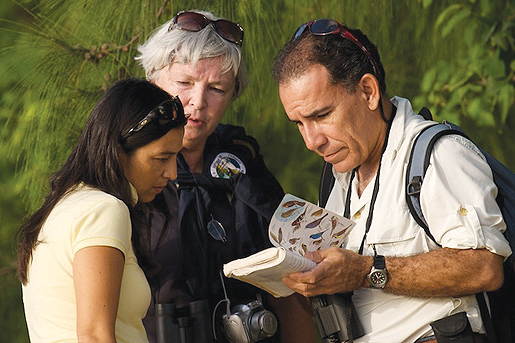Low-Impact Development Comes to Puerto Rico
 |
By Nancy Richardson
Bahia Beach Resort was established more than four years ago with a vision to create an upscale and exotic resort, focusing on natural elements as the main attraction. That vision comes alive as vegetation seems to enfold guests as they enter the lushly framed entryway to Bahia Beach Resort. The 470-acre property, located in Rio Grande, Puerto Rico, was originally a Spanish coconut palm plantation. Rows of tall, one-hundred year-old-plus palms are still found on the property today.
From a coconut plantation to a resort community, changes included a totally renovated 18-hole course re-designed by Robert Trent Jones II, estate single-family homes, golf villas, town homes, and a five-star St. Regis hotel-spa and small commercial center. The property was previously permitted as a planned development, but only the golf course was constructed. Because the master plan for the community was conceived and designed around the natural setting, 65% of the property’s green areas have been conserved.
Not only was Audubon International impressed by the beauty of the property, but we also were concerned with the project’s possible impact on regionally significant acreage. Bahia Beach Resort is situated northwest of the mouth of the Espiritu Santo River and its associated wetlands. This is the only navigable river in Puerto Rico and it forms the southern property boundary with the Atlantic Ocean to the northeast and east. Just as significant is that the Espiritu Santo River originates in the El Yunque rainforest, which along with the El Yunque Mountains, are clearly seen from the property. This 28,000-acre forest is one of the most biologically diverse forests managed by the USDA Forest Service and the only tropical rainforest in the United States National Forest System.
Wildlife Abounds with the Leatherback Turtle
In addition to rainforest and river, there are two miles of Atlantic Ocean beach along the northern border of Bahia Beach Resort. This beach supports sea turtle nests, including those of the leatherback turtle (Dermochelys coriacea), the largest living sea turtle in the world. The head of construction for Bahia Beach is a trained leatherback volunteer who monitors the beach for nests on the mornings of nesting season. Hatching starts in June with an average of 550 turtles hatched from this two mile stretch of beach. The most vulnerable stages in a leatherback's life are their early life stages when they are most vulnerable to predation of all kinds. We applaud Bahia Beach’s effort to help save a species from extinction.
Using Non-natives to Deal With Invasives
In May 2008, an invasive submersed plant in the ponds on the site was identified as Najas marina, (spiny naiad), which is a native annual plant that is very invasive under certain conditions. It enjoys the higher salinity and increase in sunlight on the pond bottom. Both hand removal and biological controls are the main treatments to pursue integrated management for the thirty-plus acres of lakes and ponds. As one method, Bahia Beach decided to introduce grass carp to the lakes to eat the spiny naiad.
For the importation of grass carp, a permit from the Department of Natural Resources (DNR) was needed. In January, the grass carp arrived and were held in tanks until they acclimated to the water salinity. A cage was built on the lake to make transition easier and quicker. The success of this project will be followed by the University of Puerto Rico. A graduate intern is working with the carp for her research project in coordination with the DNR. The control was approved as a research project because not enough information about weed control and grass carp is available for Puerto Rico.
Birds of Bahia
The highlight of the trip as far as wildlife was concerned was the bird walk. Perhaps like many guests at Bahia, I came with a list of birds that I hoped to see during my visit. An early morning walk yielded the black-faced grassquit (Tiaris bicolor) but I was unable to spot the Puerto Rican woodpecker (Melenerpes portoricensis). Our guide was Alexis Molinaris, native wildlife and plant specialist. Joining us was Marcela Canon, natural resource manager for Bahia, and Wilo Benet, internationally famous chef and wildlife photographer (my kind of guy). We birded by boat to visit and navigate the waterways, lakes, and around the island, and were rewarded with brown pelican, tri-colored heron, snowy egret, green heron, black-crowned night heron, belted kingfisher, osprey, semi-palmated plover, spotted sandpiper, and my view of the Carribean coot (Fulica caribaea). By land, we were serenaded by the grey kingbird, a loud greater Antillean grackle, and a feisty American kestrel. The current inventory of birds for Bahia Beach Resort numbers forty-four. This is the base line number, and we look forward to the additions to that inventory in the years to come.
The goal of Audubon International’s visit was to review the resort to determine if it had been developed sustainably and with low-impact to the environment. Bahia Beach Resort did indeed meet that mandate and was certified as the first Gold Signature Sanctuary in Puerto Rico. In coming articles, we will look at other aspects of development, including outreach and education, and the preservation and creation of wildlife habitat.
Nancy Richardson is the director of the Audubon Signature Program and the Audubon Classic Program for Audubon International. She can be reached at nrichardson@auduobninternational.org. For more information about Audubon International, please visit: www.auduboninternational.org.
